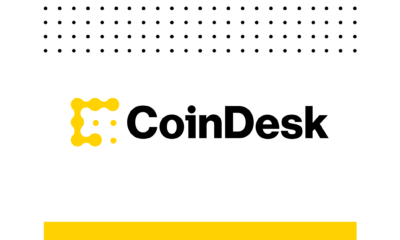Uncategorized
Top Bitcoin miners produced nearly $800M of BTC in Q1 2025
Published
2 weeks agoon
By
admin
The largest publicly traded Bitcoin mining companies produced nearly $800 million worth of Bitcoin in the first quarter of 2025, reflecting continued growth across the sector as Bitcoin prices held near record highs.
According to publicly available data compiled by Cointelegraph, the top Bitcoin mining companies produced over 9,700 Bitcoin (BTC) in the first quarter. With Bitcoin trading at around $81,600 at the time of writing, the total production was valued at around $800 million.
Marathon Digital, the biggest Bitcoin mining company by market capitalization, led the pack with 2,285 Bitcoin (worth roughly $186 million) mined in Q1.
On April 3, Marathon announced that it produced 829 BTC in March, up 17.4% from February and 10.5% higher than January.
Related: Bitcoin miner Bitfarms secures up to $300M loan from Macquarie
Bitcoin miners produce 9,746 BTC in Q1 2025
CleanSpark followed with 1,950 BTC mined in Q1, valued near $160 million. CleanSpark’s March performance also saw a 13.4% increase month-on-month.
Iren, formerly Iris Energy, produced the third-highest amount for the quarter. The mining firm reported a total of 1,513 BTC, worth almost $124 million.
Its 533 BTC produced in March was a 16.1% increase from its February performance. CompaniesMarketCap places Iren as the sixth-largest Bitcoin miner by market capitalization.
Riot Blockchain, which ranks second only to Marathon Digital by market capitalization, had the fourth-largest BTC production during the quarter.
The company reported production of 1,428 BTC (about $117 million) during the quarter. Like Iren, Riot produced 533 BTC in March, a 13.4% increase from February.
Top Bitcoin miners by market cap. Source: CompaniesMarketCap
Hut8 shows 91% growth in Bitcoin production
Hut 8 Mining, despite producing the least amount of Bitcoin among the top miners reviewed, showed the highest growth rate. The company mined 199 BTC in Q1 valued at about $16 million, including 88 BTC in March. That represents a 91% increase from the 46 BTC it produced in February.
On March 31, Hut8 partnered with US President Donald Trump’s sons, Donald Trump Jr. and Eric Trump, to launch a new mining venture called American Bitcoin. The project aims to be the “world’s largest, most efficient pure-play Bitcoin miner.”
In a previous Cointelegraph interview, Hut 8 CEO Asher Genoot said the company aims to dominate US Bitcoin mining. Genoot said the company plans to build one of the largest and most efficient Bitcoin mining platforms rooted in American soil.
Magazine: Memecoin degeneracy is funding groundbreaking anti-aging research
This Week in Crypto Games: Ubisoft’s ‘Might & Magic’, ‘Peaky Blinders’ in Development Why Arbitrum-Nvidia Partnership Collapsed – And What It Means for Web3 Tariff Carnage Starting to Fulfill BTC’s ‘Store of Value’ Promise The cost of innovation — Regulations are Web3’s greatest asset Best Crypto to Buy as Derivatives Exchange CME Set to Launch XRP Futures Metaplanet Buys Additional ¥1.92 Billion Worth Of Bitcoin Published on By Opinion by: Hedi Navazan, chief compliance officer at 1inch Web3 needs a clear regulatory system that addresses innovation bottlenecks and user safety in decentralized finance (DeFi). A one-size-fits-all approach cannot be achieved to regulate DeFi. The industry needs custom, risk-based approaches that balance innovation, security and compliance. A common critique is that regulatory scrutiny leads to the death of innovation, tracing this situation back to the Biden administration. In 2022, uncertainty for crypto businesses increased following lawsuits against Coinbase, Binance and OpenSea for alleged violations of securities laws. Under the US administration, the Securities and Exchange Commission agreed to dismiss the lawsuit against Coinbase, as the agency reversed the crypto stance, hinting at a path toward regulation with clear boundaries. Many would argue that the same risk is the same rule. Imposing traditional finance requirements on DeFi simply will not work from many aspects but the most technical challenges. Openness, transparency, immutability, and automation are key parameters of DeFi. Without clear regulations, however, the prevalent issue of “Ponzi-like schemes” can divert focus from effective innovation use cases to conjuring a “deceptive perception” of blockchain technology. Guidance and clarity from regulatory bodies can reduce significant risks for retail users. Policymakers should take time to understand DeFi’s architecture before introducing restrictive measures. DeFi needs risk-based regulatory models that understand its architecture and address illicit activity and consumer protection. The entire industry highly recommends implementing a self-regulatory framework that ensures continuous innovation while simultaneously ensuring consumer safety and financial transparency. Take the example of DeFi platforms that have taken a self-regulatory approach by implementing robust security measures, including transaction monitoring, wallet screening and implementing a blacklist mechanism that restricts a wallet of suspicion with illicit activity. Sound security measures would help DeFi projects monitor onchain activity and prevent system misuse. Self-regulation can help DeFi projects operate with greater legitimacy, yet it may not be the only solution. It’s no secret that institutional players are waiting for the regulatory green light. Adding to the list of regulatory frameworks, Markets in Crypto-Assets (MiCA) sets stepping stones for future DeFi regulations that can lead to institutional adoption of DeFi. It provides businesses with regulatory clarity and a framework to operate. Many crypto projects will struggle and die as a result of higher compliance costs associated with MiCA, which will enforce a more reliable ecosystem by requiring augmented transparency from issuers and quickly attract institutional capital for innovation. Clear regulations will lead to more investments in projects that support investor trust. Anonymity in crypto is quickly disappearing. Blockchain analytics tools, regulators and companies can monitor suspicious activity while preserving user privacy to some extent. Future adaptations of MiCA regulations can enable compliance-focused DeFi solutions, such as compliant liquidity pools and blockchain-based identity verification. The banks’ iron gate has been another significant barrier. Compliance officers frequently witness banks erect walls to keep crypto out. Bank supervisors distance companies that are out of compliance, even if it’s indirect scrutiny or fines, slamming doors on crypto projects’ financial operations. Clear regulations will address this issue and make compliance a facilitator, not a barrier, for DeFi and banking integration. In the future, traditional banks will integrate DeFi. Institutions will not replace banks but will merge DeFi’s efficiencies with TradFi’s structure. Recent: Hester Peirce calls for SEC rulemaking to ‘bake in’ crypto regulation The repeal of Staff Accounting Bulletin (SAB) 121 in January 2025 mitigated accounting burdens for banks to recognize crypto assets held for customers as both assets and liabilities on their balance sheets. The previous laws created hurdles of increased capital reserve requirements and other regulatory challenges. SAB 122 aims to provide structured solutions from reactive compliance to proactive financial integration — a step toward creating DeFi and banking synergy. Crypto companies must still follow accounting principles and disclosure requirements to protect crypto assets. Clear regulations can increase the frequency of banking use cases, such as custody, reserve backing, asset tokenization, stablecoin issuance and offering accounts to digital asset businesses. Experts pointing out concerns about DeFi’s over-regulation killing innovation can now address them using “regulatory sandboxes.” These dispense startups with a “secure zone” to test their products before committing to full-scale regulatory mandates. For example, startups in the United Kingdom under the Financial Conduct Authority are thriving using this “trial and error” method that has accelerated innovation. These have enabled businesses to test innovation and business models in a real-world setting under regulator supervision. Sandboxes could be accessible to licensed entities, unregulated startups or companies outside the financial services sector. Similarly, the European Union’s DLT Pilot Regime advances innovation and competition, encouraging market entry for startups by reducing upfront compliance costs through “gates” that align legal frameworks at each level while upgrading technological innovation. Clear regulations can cultivate and support innovation through open dialogue between regulators and innovators. Opinion by: Hedi Navazan, chief compliance officer at 1inch. This article is for general information purposes and is not intended to be and should not be taken as legal or investment advice. The views, thoughts, and opinions expressed here are the author’s alone and do not necessarily reflect or represent the views and opinions of Cointelegraph. Published on By Key takeaways: Data suggests that Bitcoin currently trades at a 40% discount. Over 36,000 Bitcoin were withdrawn from Coinbase and Binance on April 25. Bitcoin’s fractal pattern from Q4 2024 could propel prices above $100,000 in April. Bitcoin (BTC) is currently trading at a 40% discount to its intrinsic value, according to Capriole Investments founder Charles Edwards. In a recent post on X, Edwards highlighted that since the April 2024 halving, which reduced block rewards to 3.125 BTC, Bitcoin’s energy value—an estimate based on mining costs and energy consumption—stands at $130,000. Recent data from CryptoQuant indicated that over 8,756 BTC ($830 million) were withdrawn from Coinbase on April 24. Negative netflows from Coinbase could point toward institutional buying, or ETF-related purchases reflecting underlying demand. This development lines up with the spot Bitcoin ETF inflows witnessed this week. Bloomberg ETF analyst Eric Balchunas suggests that institutions went on a $3 billion ‘Bitcoin bender’ over the past few days. Binance also witnessed exchange outflows of 27,750 BTC on April 25. Alphractal founder Joao Wedson noted that “this is the third largest Bitcoin outflow in the exchange’s history.” Although large outflows and positive price action suggest bullish tailwinds, Wedson said they do not automatically mean a continued rally. The analyst said, “In 2021, massive outflows didn’t prevent the dump triggered by China’s crypto ban (April–May). On the other hand, continuous outflows over several days, like during the FTX collapse, signaled a bottom and recovery.” Related: Bitcoin ETFs on $3B ‘bender,’ log first full week of inflows in 5 weeks Bitcoin’s weekly performance marks its highest return in 2025 and its most significant uptick since November 2024. Besides similar returns, the BTC price also reflects identical price action. As illustrated in the 1-day chart, Bitcoin is consolidating at a higher range after its breakout, mirroring its behavior from Q4, 2024. (circled). After a 13% rise between Nov. 5-9, BTC posted another 15% increase during Nov. 10-11. The breakout took place during the weekend as well. Similarly, BTC prices have risen 11% between April 21-25. With the relative strength index (RSI) also exhibiting similar buying pressure, a 7-10% jump over the next few days could take BTC above $100,000. While fractal patterns may repeat, they aren’t perfectly reliable. Unlike Q4, when Bitcoin entered price discovery and rallied without resistance, the current overhead resistance level at $96,100 could impede a breakout. Related: Bitcoin spikes to 7-week highs as analyst doubts chances of $100K rebound This article does not contain investment advice or recommendations. Every investment and trading move involves risk, and readers should conduct their own research when making a decision. Published on By Update (April 26 at 8:57 PM UTC): This article has been updated to include updates from Loopscale. Solana decentralized finance (DeFi) protocol Loopscale temporarily halted its lending markets after suffering an approximately $5.8 million exploit. On April 26, a hacker siphoned approximately 5.7 million USDC (USDC) and 1200 Solana (SOL) from the lending protocol after taking out a “series of undercollateralized loans”, Loopscale co-founder Mary Gooneratne said in an X post. Loopscale has since “re-enabled loan repayments, top-ups, and loop closing”, but “[a]ll other app functions (including Vault withdrawals) are still temporarily restricted while we investigate and ensure mitigation of this exploit,” Loopscale said in an April 26 X post. The exploit only impacted Loopscale’s USDC and SOL vaults and the losses represent around 12% of Loopscale’s total value locked (TVL), Gooneratne added. “Our team is fully mobilized to investigate, recover funds, and ensure users are protected,” Gooneratne said. In the first quarter of 2025, hackers stole more than $1.6 billion worth of crypto from exchanges and on-chain smart contracts, blockchain security firm PeckShield said in an April report. More than 90% of those losses are attributable to a $1.5 billion attack on ByBit, a centralized cryptocurrency exchange, by North Korean hacking outfit Lazarus Group. Related: Crypto hacks top $1.6B in Q1 2025 — PeckShield Launched on April 10 after a six-month closed beta, Loopscale is a DeFi lending protocol designed to enhance capital efficiency by directly matching lenders and borrowers. It also supports specialized lending markets, such as “structured credit, receivables financing, and undercollateralized lending,” Loopscale said in an April announcement shared with Cointelegraph. Loopscale’s order book model distinguishes it from DeFi lending peers such as Aave that aggregate cryptocurrency deposits into liquidity pools. Loopscale’s main USDC and SOL vaults yield APRs exceeding 5% and 10%, respectively. It also supports lending markets for tokens such as JitoSOL and BONK (BONK) and looping strategies for upwards of 40 different token pairs. The DeFi protocol has approximately $40 million in TVL and has attracted upwards of 7,000 lenders, according to researcher OurNetwork. Magazine: Ripple says SEC lawsuit ‘over,’ Trump at DAS, and more: Hodler’s Digest, March 16 – 22 Arthur Hayes, Murad’s Prediction For Meme Coins, AI & DeFi Coins For 2025 Expert Sees Bitcoin Dipping To $50K While Bullish Signs Persist 3 Voting Polls Show Why Ripple’s XRP Price Could Hit $10 Soon Aptos Leverages Chainlink To Enhance Scalability and Data Access Bitcoin Could Rally to $80,000 on the Eve of US Elections Crypto’s Big Trump Gamble Is Risky Institutional Investors Go All In on Crypto as 57% Plan to Boost Allocations as Bull Run Heats Up, Sygnum Survey Reveals Sonic Now ‘Golden Standard’ of Layer-2s After Scaling Transactions to 16,000+ per Second, Says Andre Cronje
Source link You may like












Uncategorized
The cost of innovation — Regulations are Web3’s greatest asset


DeFi’s challenges and rules
Self-regulatory frameworks cultivate transparency and security in DeFi
Clear structure and governance are key
Regulatory clarity can break barriers to DeFi integration
Building bridges between regulators and innovators in DeFi
Source link Uncategorized
Bitcoin trades at ‘40% discount’ as spot BTC ETF buying soars to $3B in one week

Can this Bitcoin fractal push BTC above $100K in April?
Source link Uncategorized
Solana’s Loopscale pauses lending after $5.8M hack

Unique DeFi lending model
Source link 
This Week in Crypto Games: Ubisoft’s ‘Might & Magic’, ‘Peaky Blinders’ in Development

Why Arbitrum-Nvidia Partnership Collapsed – And What It Means for Web3

Tariff Carnage Starting to Fulfill BTC’s ‘Store of Value’ Promise

The cost of innovation — Regulations are Web3’s greatest asset

Best Crypto to Buy as Derivatives Exchange CME Set to Launch XRP Futures

Metaplanet Buys Additional ¥1.92 Billion Worth Of Bitcoin

Here Are Four Signs the Stock Market Has Bottomed, According to Fundstrat’s Tom Lee

Bitcoin dips below $94,000 as ETFs record $3b weekly inflow

Bitcoin Post-Halving Price Performance Is the Worst on Record. Why?

Expert Predicts Start Date For Pi Network Price Pump

GameFi Tokens Show Signs of Life After Gala Games, White House Tie-Up

Bitcoin trades at ‘40% discount’ as spot BTC ETF buying soars to $3B in one week

Bitcoin Continues To Flow Out Of Major Exchanges — Supply Squeeze Soon?

BlackRock’s Bitcoin ETF Sees $643 Million Inflows

DePIN Altcoin Outpaces Crypto Market and Skyrockets by Nearly 44% Following High-Profile Exchange Listing

Arthur Hayes, Murad’s Prediction For Meme Coins, AI & DeFi Coins For 2025

Expert Sees Bitcoin Dipping To $50K While Bullish Signs Persist

3 Voting Polls Show Why Ripple’s XRP Price Could Hit $10 Soon

Aptos Leverages Chainlink To Enhance Scalability and Data Access

Bitcoin Could Rally to $80,000 on the Eve of US Elections

Crypto’s Big Trump Gamble Is Risky

Institutional Investors Go All In on Crypto as 57% Plan to Boost Allocations as Bull Run Heats Up, Sygnum Survey Reveals

Sonic Now ‘Golden Standard’ of Layer-2s After Scaling Transactions to 16,000+ per Second, Says Andre Cronje

The Future of Bitcoin: Scaling, Institutional Adoption, and Strategic Reserves with Rich Rines

Ripple-SEC Case Ends, But These 3 Rivals Could Jump 500x

Has The Bitcoin Price Already Peaked?

A16z-backed Espresso announces mainnet launch of core product

Xmas Altcoin Rally Insights by BNM Agent I

Blockchain groups challenge new broker reporting rule

I’m Grateful for Trump’s Embrace of Bitcoin
Trending


















